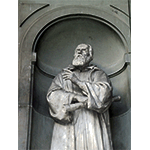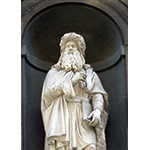The Uffizi Loggia
During the first half of the 19th century, 28 marble statues commemorating illustrious Tuscans were placed in the niches in the pillars of the Uffizi loggia. The sculptural cycle portrays the fathers and defenders of the homeland, the fathers of the arts of drawing as well as poets, politicians, historians and men of science.
The series of scientists opens with the statue of Galileo Galilei, sculpted by Aristodemo Costoli in 1851 and placed on the shorter side of the Uffizi. The Pisan scientist is shown holding a telescope, the emblematic instrument of the revolution in astronomy, with which he inaugurated the era of telescopic astronomy. Starting from 1609, Galileo observed for the first time the mountains and valleys of the Moon, the curious figure of Saturn, the phases of Venus, the stars that made up the Milky Way, sunspots and the satellites of Jupiter, which he dedicated to the Medici family, calling them "Medicean stars". These discoveries constituted significant proofs in favour of the Copernican system.
Another scientist portrayed in the loggia is Francesco Redi from Arezzo (P. Costa, 1854). A member of the Accademia del Cimento and the Accademia della Crusca, personal physician to the Medici Grand Dukes, naturalist and man of letters, Redi effectively represents the figure of the seventeenth-century court scientist and intellectual. Through a world-famous experiment, he showed the belief in the spontaneous generation of insects to be false.
Among the other scientists portrayed are the famous sixteenth-century botanist Andrea Cesalpino (P. Fedi, 1854), Pier Antonio Micheli (V. Consani, 1856), considered the founder of mycology, the anatomist Paolo Mascagni (L. Caselli, 1852) and Leonardo da Vinci (L. Pampaloni, 1842).
****************************
Texts by Graziano Magrini
English translation by Catherine Frost
Last update 19/feb/2008





